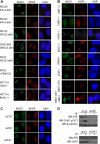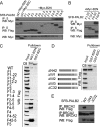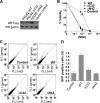PALB2 regulates recombinational repair through chromatin association and oligomerization
- PMID: 19423707
- PMCID: PMC2709360
- DOI: 10.1074/jbc.M109.016717
PALB2 regulates recombinational repair through chromatin association and oligomerization
Abstract
Maintenance of genomic stability ensures faithful transmission of genetic information and helps suppress neoplastic transformation and tumorigenesis. Although recent progress has advanced our understanding of DNA damage checkpoint regulations, little is known as to how DNA repair, especially the RAD51-dependent homologous recombination repair pathway, is executed in vivo. Here, we reveal novel properties of the BRCA2-associated protein PALB2 in the assembly of the recombinational DNA repair machinery at DNA damage sites. Although the chromatin association of PALB2 is a prerequisite for subsequent BRCA2 and RAD51 loading, the focal accumulation of the PALB2 x BRCA2 x RAD51 complex at DSBs occurs independently of known DNA damage checkpoint and repair proteins. We provide evidence to support that PALB2 exists as homo-oligomers and that PALB2 oligomerization is essential for its focal accumulation at DNA breaks in vivo. We propose that both PALB2 chromatin association and its oligomerization serve to secure the BRCA2 x RAD51 repair machinery at the sites of DNA damage. These attributes of PALB2 are likely instrumental for proficient homologous recombination DNA repair in the cell.
Figures





References
-
- Bartek J., Lukas C., Lukas J. ( 2004) Nat. Rev. Mol. Cell Biol. 5, 792– 804 - PubMed
-
- Kennedy R. D., D'Andrea A. D. ( 2006) J. Clin. Oncol. 24, 3799– 3808 - PubMed
-
- Wang W. ( 2007) Nat. Rev. Genet. 8, 735– 748 - PubMed
-
- Zhang H., Tombline G., Weber B. L. ( 1998) Cell 92, 433– 436 - PubMed
-
- Gudmundsdottir K., Ashworth A. ( 2006) Oncogene 25, 5864– 5874 - PubMed
Publication types
MeSH terms
Substances
Grants and funding
LinkOut - more resources
Full Text Sources
Molecular Biology Databases
Research Materials
Miscellaneous

